

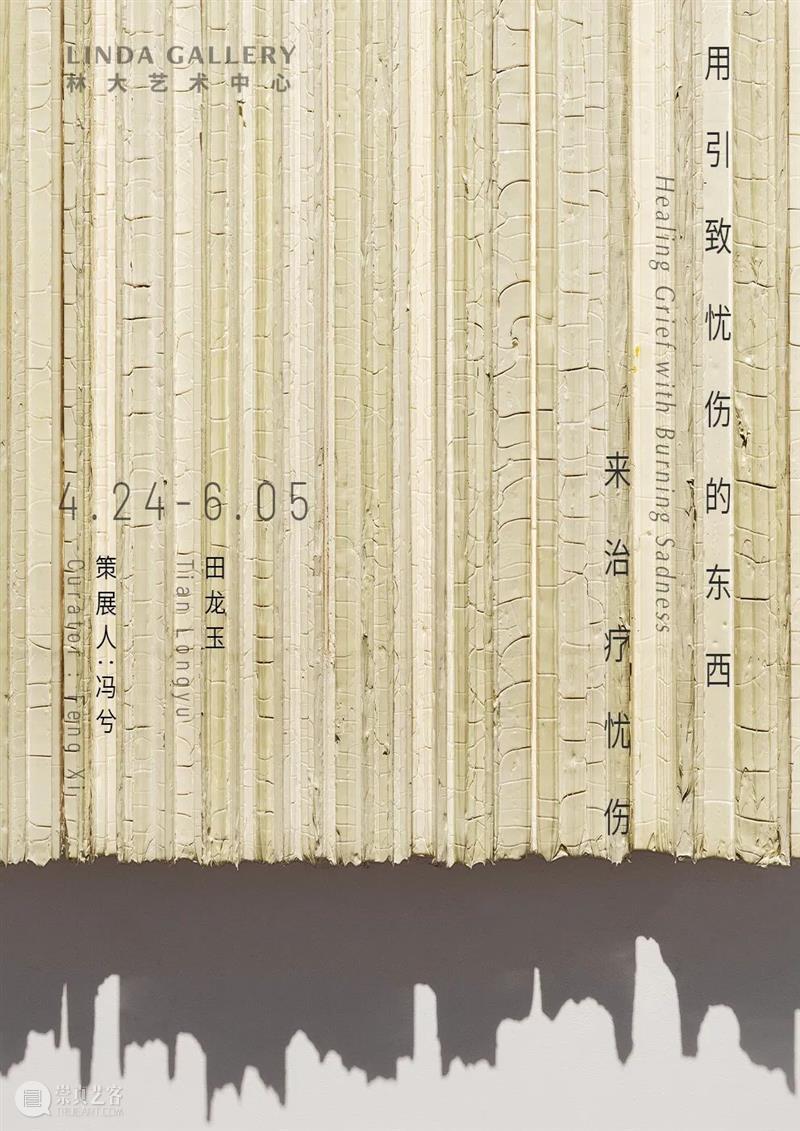
《看不见的城市》文/冯兮
《看不见的城市》是意大利作家伊塔洛·卡尔维诺创作的中篇小说。故事中,马可波罗向元朝皇帝忽必烈,描述了如何使城市进入现代化进程的宏伟蓝图。语言上的障碍,使两位主人公的交流通过肢体、行为、表情、声音以及背包中的物品,艰难且虚拟地表达给对方。在描述中,城市在无限地扩张,远远超出了人类的感知能力,城市成为一个无法驾驭的怪兽。现代化和全球化不断刷新的过程中,经济发展成为唯一的驱动力,不惜承受着失去历史和自然的代价。科技繁荣的同时,城市变得同质化,带来了后工业社会的遗患,权力和欲望异化了的城市状态,并且进入了无法逆转的恶性循环。
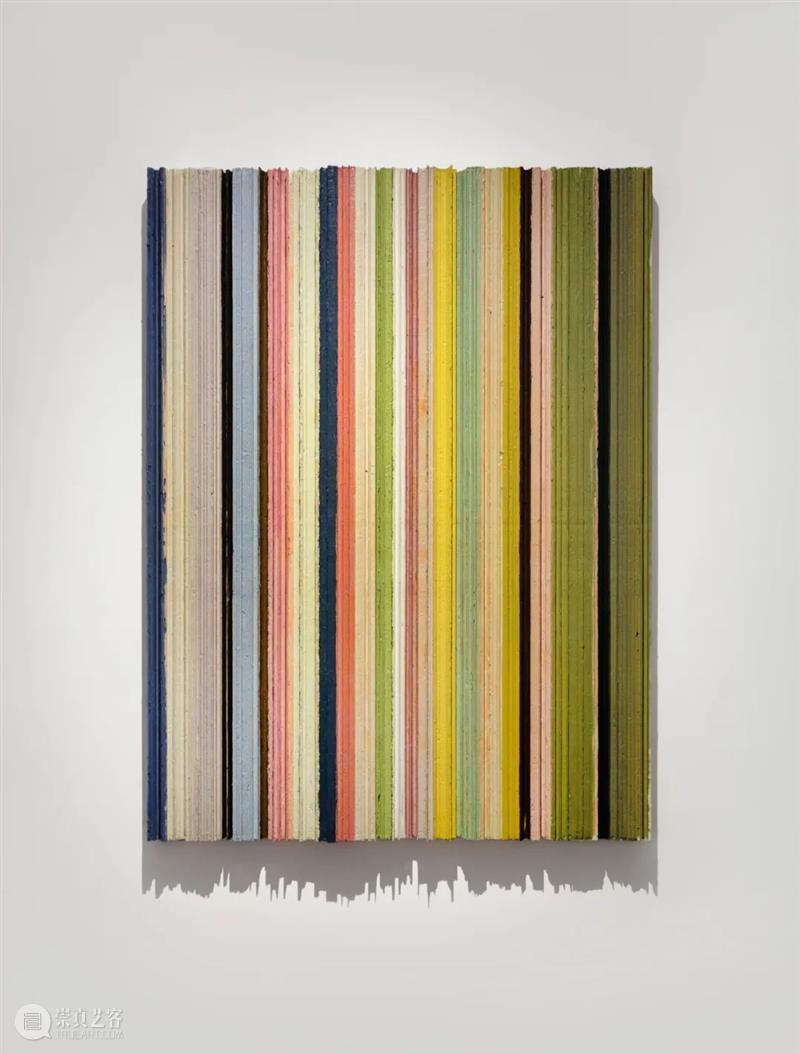
墒 200150168,The Scar 200150168,2020
木板,油画颜料, Wood, oil paints
200 × 150 × 16.8 cm
田龙玉的青少年时期,往来于城市和农村之间。农村春耕的时候,他随大人学习用犁耙翻地,翻过的土表层松软,他和伙伴们在上面打滚儿玩耍。农村城市化的进程,土地失去土壤,换来钢筋水泥灌溉出连绵的高楼大厦。伴随着同步节拍的拆除和搬迁的进行曲,新农村建设作为城市现代化进程的复调,共同谱写着经济发展的音阶。多年后,身处城市的田龙玉,心中往复着农村与城市的生活经验与情感,使他成为被现代化改造,却饱含乡愁的人群中的一员。和每位北漂的艺术家一样,无数次地经历了拆迁和搬家的命运,成为 “有居无家” 的状态。
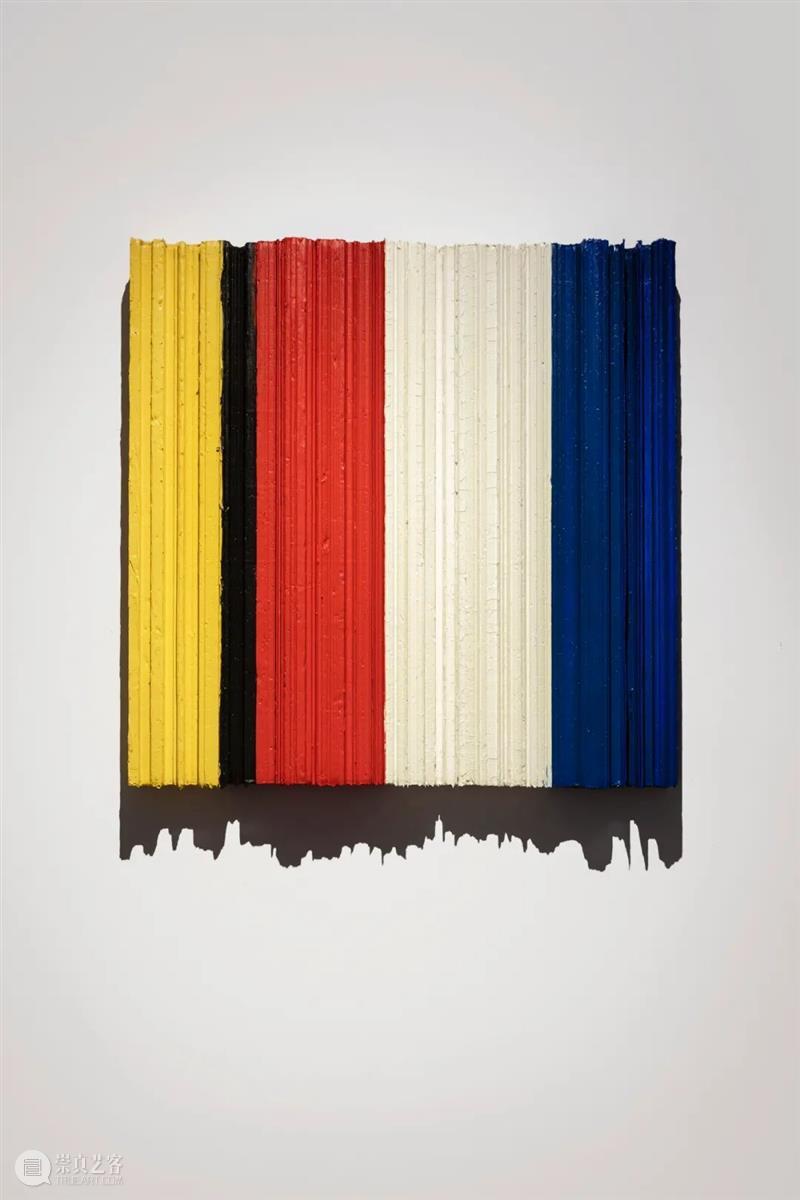
墒 120120166,The Scar 120120166,2020
木板,油画颜料,Wood, oil paints
120 × 120 × 16.6 cm
对于土地的情感,田龙玉以艺术家的角度,将油画颜料视为其精神的土壤,厚重的颜色填满设计好的框架。作为记忆中的原型,犁耙是耕耘土地的工具,在田龙玉系列作品《墒》的创作方法中,城市的天际线构成了犁耙的新造型,通过对颜料耙、刮和带走色彩的动作,语言进行转换时,既保持了工具原始的功能,也将其赋予了类似于“凶器”的模样。“精神土壤” 残留下的沟壑,通过正上方光源的直射,映射出城市的倒影,那是绵延起伏的黑影,好像白色墙面生长出的一条 “疼痛的曲线” 。
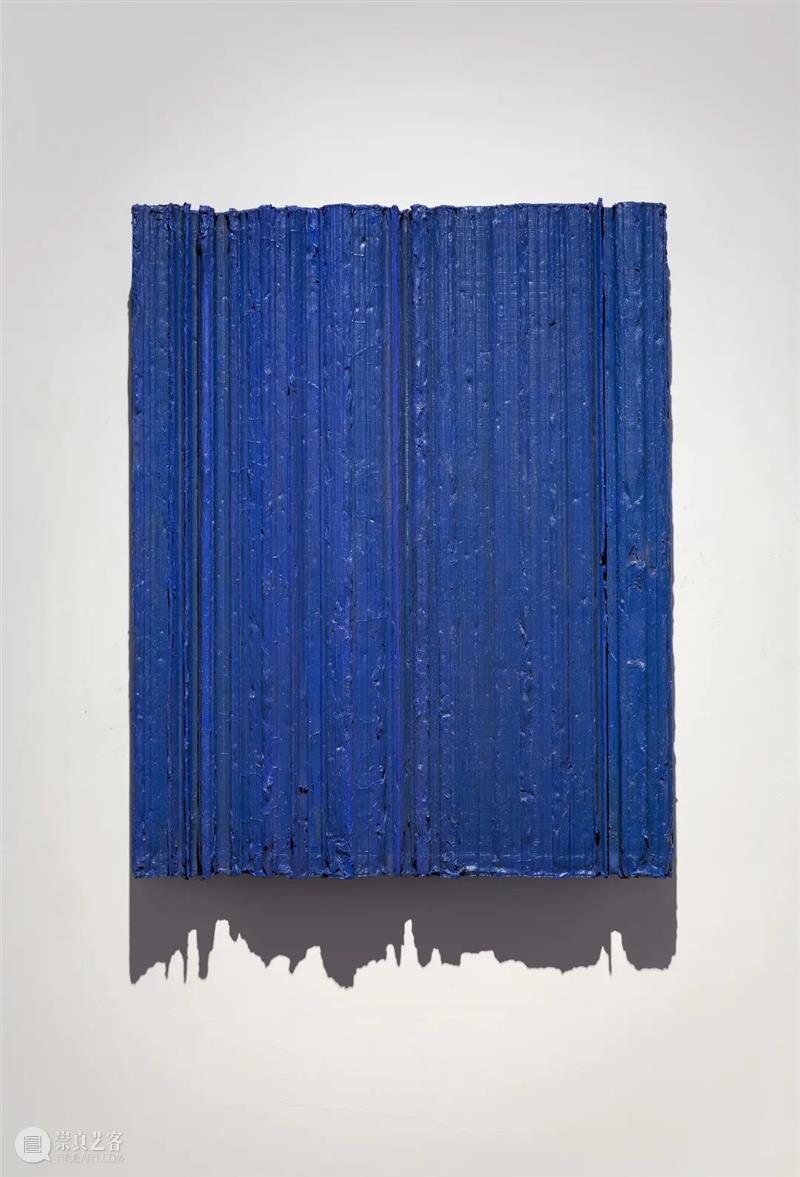
墒 1008015,The Scar 1806015,2019
木板,油画颜料,Wood, oil paints
100 × 80 × 15 cm
在展览中,通过灯光塑造出的一条条城市连绵的影子,与凹凸有序且色彩艳丽的 “画面” ,形成了立体和平面的对峙关系。看似抽象的画面,实际与抽象无关,形态上既不是雕塑的造型方式,更加不属于绘画的语言,笔直的沟壑是耙子刮扯过所存留的痕迹,一个模拟劳动行为的定格,是关于身体和汗水的音符。被带走的色彩遭到遗弃,留下的是被耙子的制式选择而成的形象,刮扯的行为是塑造与抛弃的过程,如同建筑的建设与拆除并存,隐含着 “双向” 的表达意图。“精神意识” 所失去的 “土地” ,变成了看似 “抽象” 表达的图像,高低不平的颜色,是被现实一次次划过留下的伤痕与记忆。对于田龙玉来说,他在制造 “案发现场” ,那些由于城市的过度发展以及其背后的资本和权力,给予生活中的家庭与精神上的家园所带来的创伤。
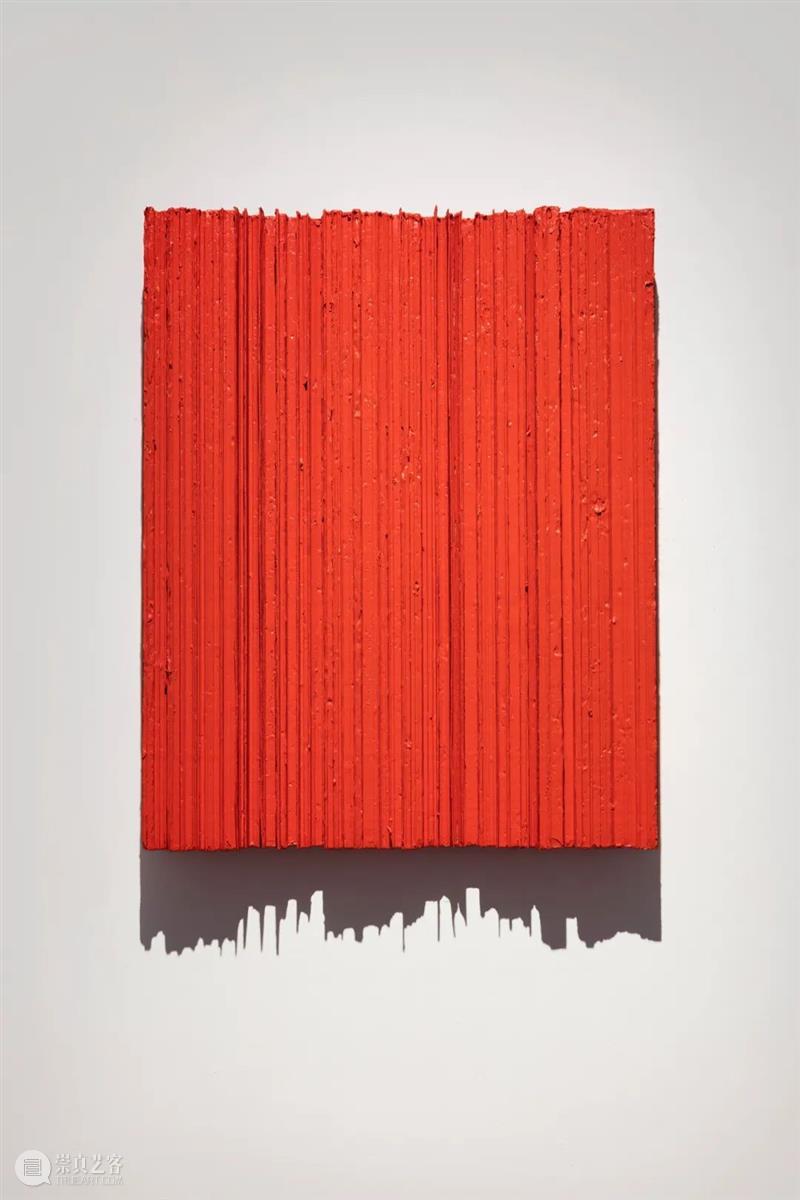
墒 10080146,The Scar 10080146,2020
木板,油画颜料,Wood, oil paints
100 × 80 × 14.6 cm
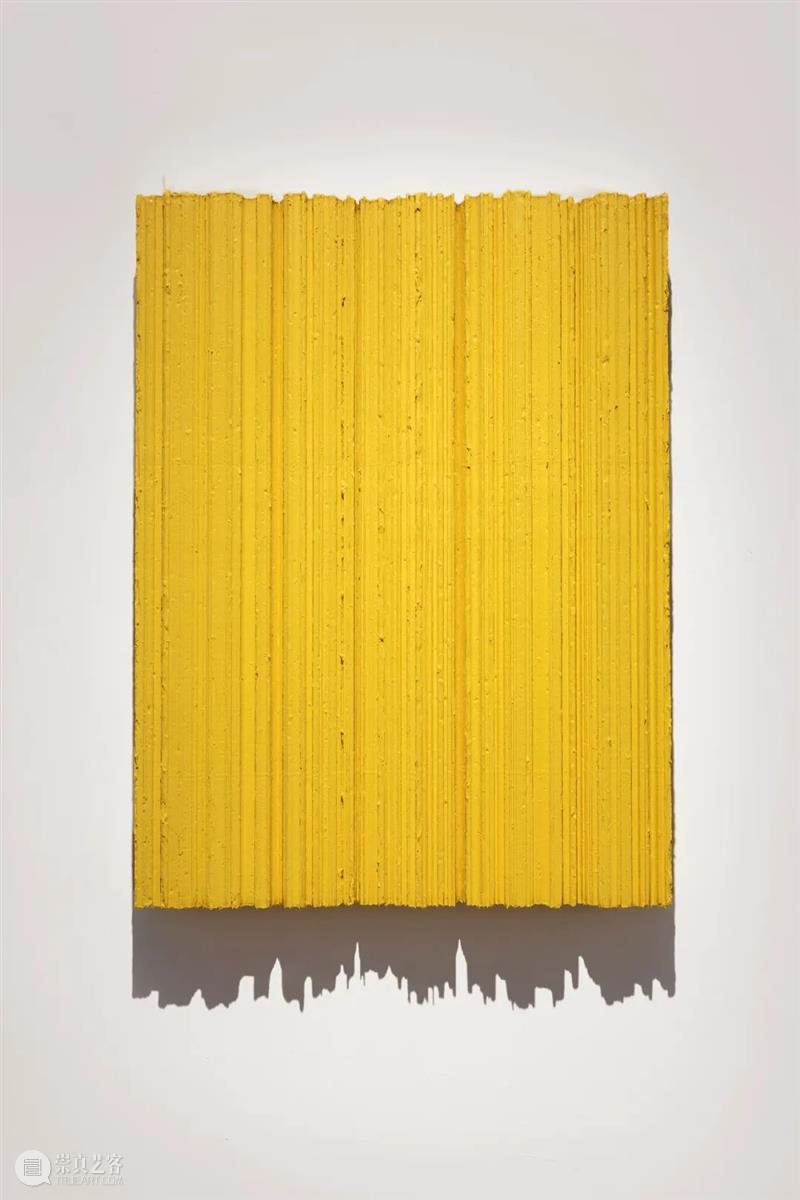
墒 10080155,The Scar 10080155,2019
木板,油画颜料,Wood, oil paints
100 × 80 × 15.5 cm
创造并使用工具,是田龙玉最为重要的工作方法,本次展览同时展出了两件铁板制作的作品,从工具衍生出另一视角的城市倒影。铁板被切割,留下 “暴力” 行为遗存的负形,一片金属气息的城市幻景。《中间地带》,远看像音频波纹般,有着一种密码在传播过程中可视化的感觉。走近后,两侧切割成锯齿状的铁板,出现了 “海市蜃楼” 般的城市风景,被锻造和规划的形状,也是契合经济发展的 “宏图”,连续的建筑群,是否真的属于我们?另一件作品《月-202112》是标准的弯月形状,上色后呈现出月球的表面,内弧是被切割出的城市负形。与《中间地带》一样,消失的正形城市去了哪里?被保留下的负形空间指向真实?还是代表着虚无?是工具的抒情?还是作品的意义?田龙玉通过两个与工具有关的作品,给展览中偏向结果化的作品提出了问题。
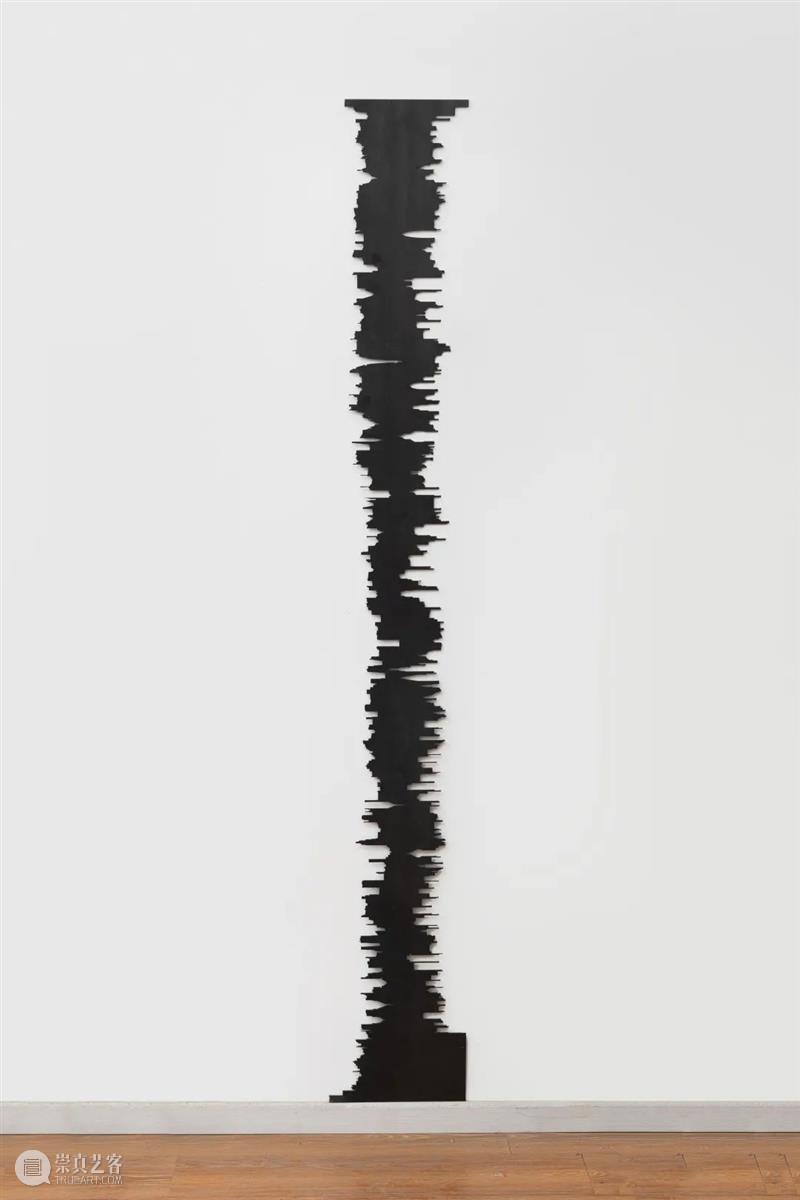
中间地带,A Middle Ground,2020
金属,Metal
204 × 30 × 0.6 cm
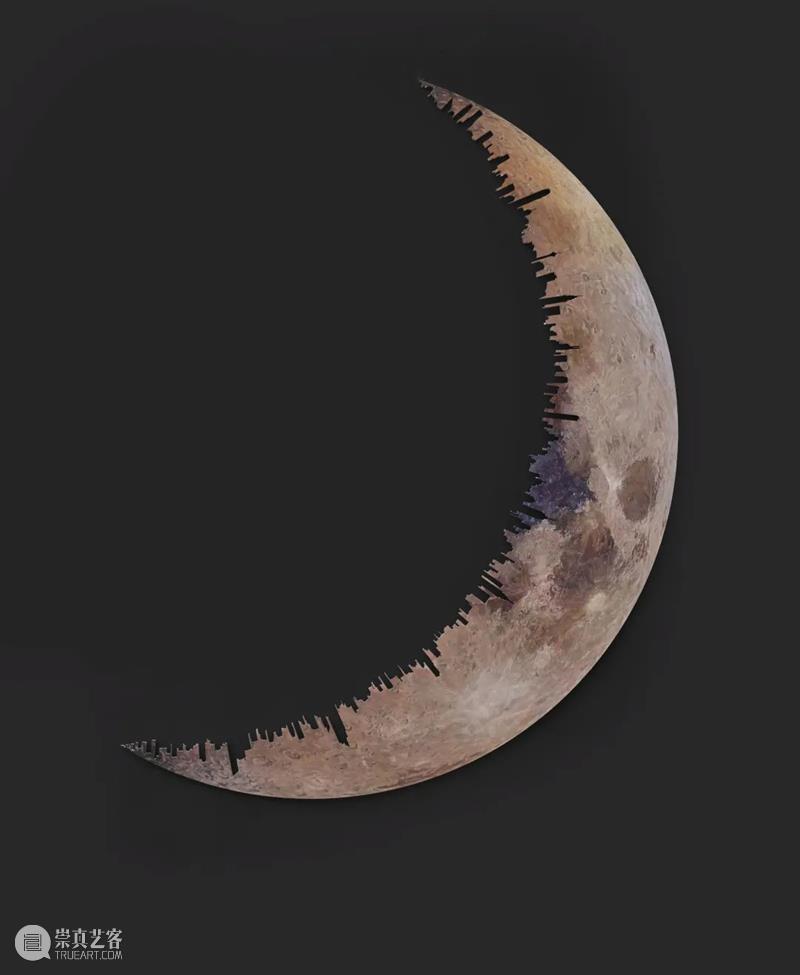
月-202112,The Moon-202112,2021
铝板油画,Aluminum plate, oil paints
110 × 60 × 1 cm
最后空间中的作品《用引致忧伤的东西来治疗忧伤》,是整个展览中相对现实的指向,作为装置创作的形式同样明确。挖掘机的铲钩,在建筑中是基础的工具,同样具有建设与拆除的两个指向。现实中,能见到挖掘机的机会不多,通常经历在拆迁的现场,一勾一拉,屋顶墙面灰飞烟灭。被权力赋予的权力,在众生受难的同时,伴随着冷漠的刚猛,尤为凸显。田龙玉将象征权力的高楼大厦,焊接成挖掘机的钢齿,权力的建设、城市的发展与 “他者” 的生活,共同焊铸在左右命运的工具之上。 “用引致忧伤的东西来治疗忧伤” 是一句浪漫的诗,也是一部无情的现实著作。
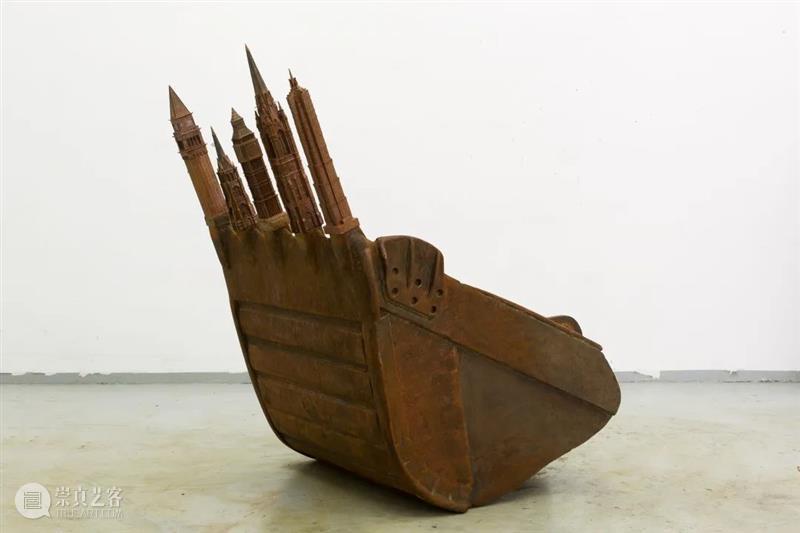
用引致忧伤的东西来治疗忧伤1,Healing Grief with Burning Sadness 1,2018-2019
铸铁,Cast iron
200 × 150 × 240 cm
展览《用引致忧伤的东西来治疗忧伤》,用诗意化的作品,描述了一个小人物的关注点,面对现代化和全球化进程中被裹挟在城市生活,却无法逃离的人们。如同李志的歌曲《他们》:“他们指向左,他们指向右。”看得见的城市,属于他们。看不见的现实,才属于我们。
Invisible Cities By Feng Xi
“Invisible Cities” is a novel by Italian author Italo Calvino. In the story, Marco Polo describes to Kublai Khan a grand blueprint for how to modernize cities. The language barrier between the two protagonists forces them to communicate with some difficulty through gestures, actions, expressions, sounds and objects pulled from a bag. In these descriptions, cities expand endlessly, far surpassing the human capacity to understand, they become like uncontrollable creatures. Amidst constant modernization and globalization, economic development has become the only driver, and the loss of history and nature is the unfortunate price we pay. Homogenized cities and booming technologies bring with them the maladies of post-industrial societies. The urban condition, characterized by the alienating forces of power and desire, has become part of an unbreakable vicious cycle.
In Tian Longyu’s youth, he moved between the city and the countryside. During spring plowing in the countryside, he learned from the adults how to turn up the soil, and he and his friends would roll around and play on the soft topsoil. With the urbanization of rural areas, that soil has been lost, traded for a sea of high rises built of reinforced concrete. Together, the synchronized march of demolition and forced moves and the polyphony of the construction of the New Countryside—a form of urban modernization—have set the tone for economic development. Many years later, Tian Longyu is living in a city, mentally moving betweenexperiences of and feelings about rural and urban life—this transformed him into a member of a group changed by modernization yet full of nostalgia. Like every artist who migrated to Beijing, Tian has encountered forced moves and demolitions numerous times. He often had a house, but not a home.
Tian Longyu approaches an emotional connection to the land from an artist’s perspective. Taking oil paint as spiritual soil, he fills a well-designed frame with thick colors. The plow and rake, elements of prototypical memory, are tools for cultivating the land. When Tian created the series “The Scar”, he added something new: city skylines. Through raking, scraping, and removing paint, he transforms the language of the work, retaining its original function, while giving it the appearance of a lethal weapon. The furrows left in the “spiritual soil” offer an inverted image of the city under harsh light from directly above. That undulating shadow is like a painful curve growing from a white wall. In the exhibition, the shadows of continuous cities created by light and the undulating, brilliantly colored images generate an antagonism between two and three dimensions. These seemingly abstract images are unrelated to abstraction. Formally, the works are neither modeled like sculptures nor painted like paintings; the perfectly straight furrows are traces left by a passing rake. This act that simulates labor symbolizes sweat and the body. The removed color is forgotten, and what remains are the forms that result from adaptations made to the rake. The act of raking is a process of definition and abandonment. Just as construction and demolition coexist, it implies a dual expressive intention. The land lost to spiritual awareness is transformed into seemingly abstract images and uneven colors, which are scars and memories left by the repeated scratches of reality. Tian creates “crime scenes” for the wounds that urban overdevelopment and the capital and power that underpin it have caused to families’ lives and spiritual homes.
Creating and using tools are Tian Longyu’s most important working methods, and this exhibition showcases two works made of sheet iron. In his inverted images of cities derived from farm tools, he cuts into iron plates, leaving behind the negative image of a “violent” action, an urban fantasy with a metallic quality. From a distance, “A Middle Ground” looks like sound waves or the visualization of a code as it is being communicated. As viewers move closer, the jagged shapes on both sides of the plate emerge, like a mirage, as an urban landscape. These forged and cut shapes also fit into the grand plan of economic development. Do these never-ending building complexes really belong to us? The “The Moon – 202112” takes the standard crescent moon shape. After coloring, the surface of the moon is visible, and the interior curve is cut into the negative image of a city. Like in “A Middle Ground”, where did the positive image of that city go? Does the remaining negative space point to the truth or represent nothing? Are we simply seeing the lyricism of tools or the meaning of the work? Through two works related to tools, Tian questions the more results-oriented works in the exhibition.
“Healing Grief with Burning Sadness”, the work in the final space, is more closely related to real situations and its form as an installation is more clear-cut. The bucket of an excavator is an essential construction tool, related to both construction and demolition. In real life, there are very few opportunities to see excavators, but they usually appear at demolition sites, clawing at roofs and walls until they collapse into clouds of grey dust. The power bestowed by power causes disaster, making its indifferent ferocity all the more obvious. Tian Longyu welded high-rise buildings that symbolize power onto the teeth of an excavator’s digging bucket. The construction of power, the development of cities, and the lives of others are welded into the tools that control our fate. “Healing Grief with Burning Sadness” is both a romantic poem and a brutal depiction of reality.
“Healing Grief with Burning Sadness” uses poetic works of art to present the perspective of ordinary people, addressing those who feel swept up in urban life yet unable to escape modernization and globalization. In “Them”, Li Zhi sang: “They point to the left, they point to the right.” Visible cities belong to them. Invisible realities belong to us.
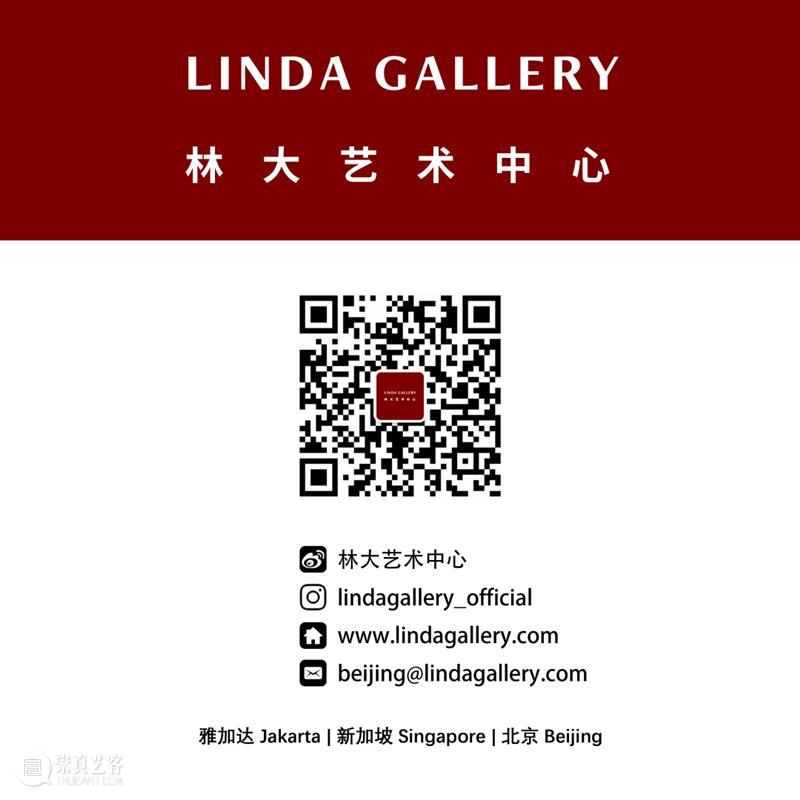


已展示全部
更多功能等你开启...





 分享
分享